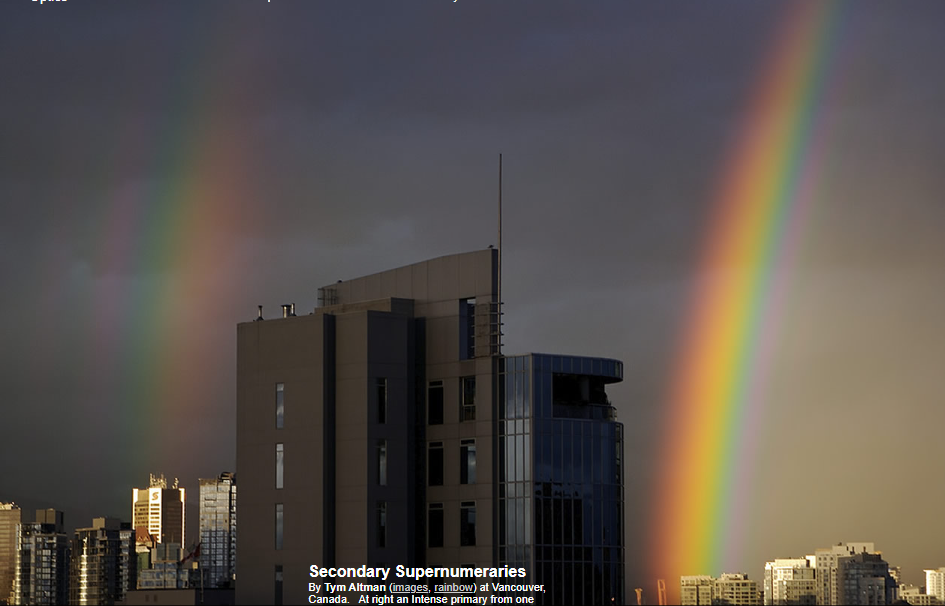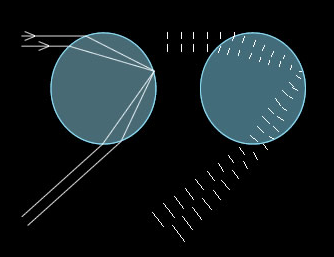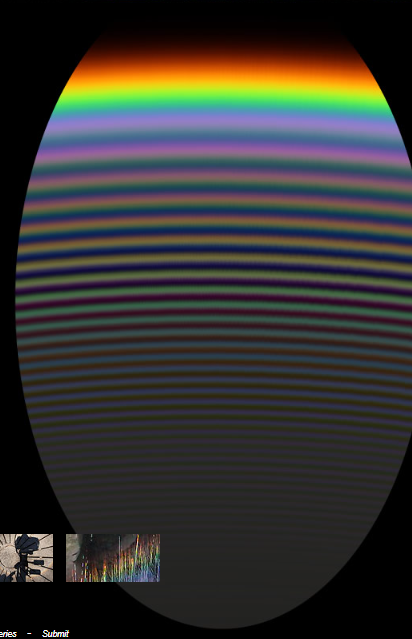OPOD - Secondary Supernumeraries
OPOD - Secondary Supernumeraries: A Detailed Exploration
Have you ever marveled at the vibrant colors and mesmerizing patterns of a rainbow? While rainbows are undoubtedly captivating, they also hold hidden wonders within them. One such phenomenon is known as secondary supernumeraries. In this article, we will delve deeper into the world of atmospheric optics to uncover the secrets behind these elusive secondary supernumeraries.
When raindrops are small, particularly towards the end of a shower, primary supernumeraries are a common sight inside the rainbow. These are the purple and green arcs that add an extra touch of magic to the already enchanting display. However, what many people may not realize is that there are secondary supernumeraries present as well, albeit fainter and often overlooked.
Unlike primary supernumeraries, which can be seen outside the secondary bow, secondary supernumeraries are rarely observed unless artificially created by hosepipes or lawn sprinklers. Their visibility is highly dependent on various factors, including the concentration of raindrops, the size of the raindrops, and their distribution. These factors can fluctuate rapidly, making the appearance of secondary supernumeraries a truly rare occurrence.
To understand the formation of supernumeraries, it is essential to grasp the wave nature of light. At any given point of a rainbow, two classical ray paths contribute to the light we perceive. However, since light behaves as a wave, the wave crests of the two emerging waves can either coincide or be out of phase depending on the viewing angle. When these wave crests align, they create a bright arc known as a supernumerary bow.
The visibility of supernumeraries is heavily influenced by the size of raindrops. Smaller drops result in more widely spaced supernumeraries, while larger drops produce denser and closer-packed arcs. Additionally, the distribution of raindrop sizes also plays a role in determining whether supernumeraries are discernible or not. Wide distributions tend to blur out the supernumeraries, making them less visible to the naked eye.
While we often see secondary supernumeraries as faint traces inside the primary rainbow, it is intriguing to imagine how they might appear under ideal conditions. Imagine a scenario where the sun is shrunk to a point to avoid blurring, and all raindrops have a uniform diameter of 0.75mm. In such a situation, calculations by AirySim reveal the true beauty of supernumeraries, showcasing them as vibrant purple bands emanating from the secondary bow.
In conclusion, secondary supernumeraries are a captivating aspect of atmospheric optics that add an extra layer of wonder to the already breathtaking display of rainbows. While primary supernumeraries steal the spotlight, these elusive secondary arcs hold their own allure. Their visibility is influenced by factors such as raindrop concentration, size, and distribution. Although rarely observed in nature, their existence reminds us of the intricate interplay between light and water droplets in our atmosphere. So, the next time you witness a rainbow, take a moment to appreciate the hidden marvels that lie within its colorful embrace.

Secondary Supernumeraries
By Tym Altman (images, rainbow) at Vancouver, Canada. At right an Intense primary from one reflection inside the raindrops. At left, the fainter reversed colour secondary from two reflections. At further left a very rare sight indeed - the purple bands of supernumeraries from the secondary bow. ©Tym Altman, shown with permission
Primary supernumeraries, purple and green arcs inside the rainbow are a common sight whenever raindrops are small as towards the end of a shower. Those outside the secondary bow are almost never seen except when manufactured by hosepipes and lawn sprinklers.
Interestingly, there are only faint traces of a supernumerary inside this primary rainbow. The visibility, or not, of supernumeraries depends critically on the local concentration, raindrop size and raindrop size distribution. These can change quickly.

Above: Primary supernumerary formation, ones outside the secondary bow are made in the same way.
A any point of a rainbow two classical ray paths contribute the light. But light is a wave phenomenon and the wave crests of the two emerging waves can coincide or otherwise be out of phase depending on the viewing angle. When the crests coincide there is a bright arc, a supernumerary bow.
Whether the supernumeraries are visible depends on the drop size, small drops have more widely spaced supernumeraries, and the drop size distribution - wide distributions blur out the supernumeraries.

Right: Supernumeraries as we never see them - from a sun shrunk to a point to avoid blurring and raindrops all 0.75mm diameter. A calculation by AirySim.
Note: this article has been automatically converted from the old site and may not appear as intended. You can find the original article here.
Reference Atmospheric Optics
If you use any of the definitions, information, or data presented on Atmospheric Optics, please copy the link or reference below to properly credit us as the reference source. Thank you!
-
<a href="https://atoptics.co.uk/blog/opod-secondary-supernumeraries/">OPOD - Secondary Supernumeraries</a>
-
"OPOD - Secondary Supernumeraries". Atmospheric Optics. Accessed on April 19, 2024. https://atoptics.co.uk/blog/opod-secondary-supernumeraries/.
-
"OPOD - Secondary Supernumeraries". Atmospheric Optics, https://atoptics.co.uk/blog/opod-secondary-supernumeraries/. Accessed 19 April, 2024
-
OPOD - Secondary Supernumeraries. Atmospheric Optics. Retrieved from https://atoptics.co.uk/blog/opod-secondary-supernumeraries/.